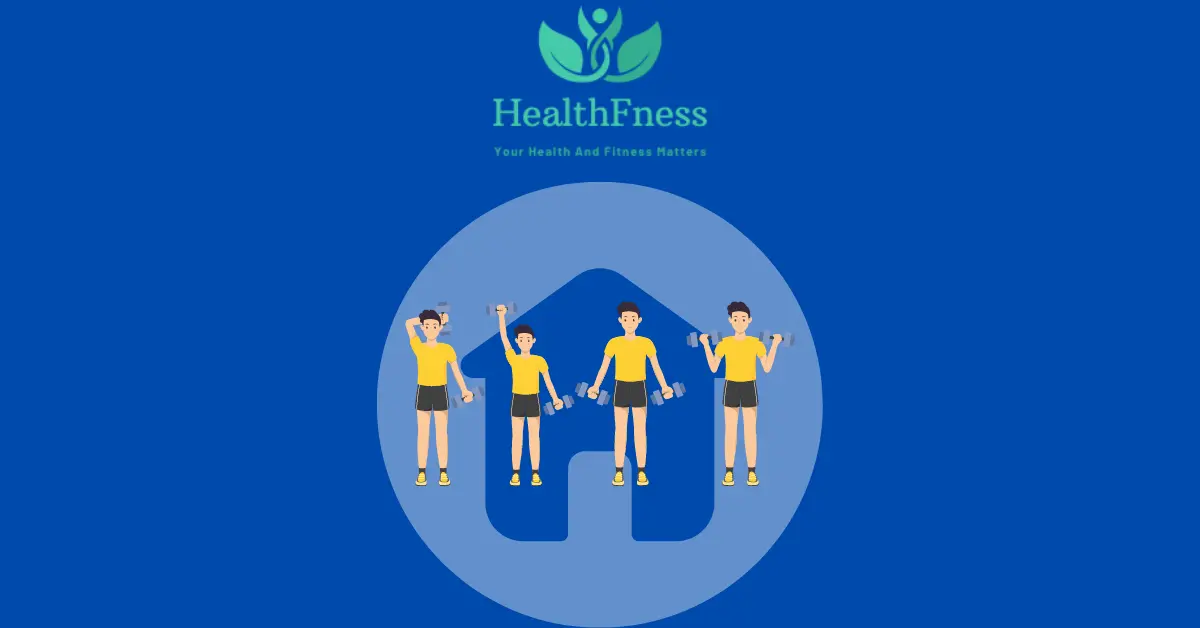Discover effective biceps workout routines for home training, enhancing arm strength and definition. Learn exercises, warm-ups, and stretches for optimal results in this comprehensive guide.
What are Biceps?
The biceps are the muscles at the front of the upper arm that play an important role in the movement and function of our arms. Strong biceps muscles are crucial for anyone who wants to increase their overall strength, stability, and look, not only athletes and bodybuilders. In this article:
Explanation of Biceps and Their Importance
Biceps are the muscles in the front of the upper arm that is responsible for flexing the arm at the elbow joint, as previously stated. Biceps are also used in various pulling or lifting actions, such as carrying groceries or picking up a child. As a result, possessing strong biceps muscles can aid in the performance of routine chores.
Importance of Working Out Biceps
Working out the biceps has various advantages, including increased upper body strength, improved athletic performance, and general health and fitness. As we exercise our biceps, we stimulate muscular growth and boost muscle fiber recruitment, which allows us to do tasks that need strength and power.
Furthermore, having strong biceps might aid in injury prevention during physical activities by giving stability and support to the shoulder joint. Biceps workouts are an important aspect of athletes’ and bodybuilders’ training routines since they assist them to improve their performance in their respective sports.
Explanation of Biceps Anatomy
The biceps muscles are divided into two sections:
Short Head of the Biceps:
- Positioned on the inside of the arm
- Responsible for elbow flexion
- Plays a role in supporting the shoulder joint during pulling and lifting activities
Long Head of the Biceps:
- Located on the outside of the arm
- Responsible for shoulder flexion and elbow flexion
- Contributes to stabilizing the shoulder joint during physical tasks
Overall, understanding the architecture of the biceps muscles will help you do effective and safe activities that target these muscles. We may create strong and well-defined biceps muscles and increase upper body strength and stability by implementing exercises that target both the short and long heads of the biceps.
Preparation for Home Biceps Workout
To minimize injuries and get optimum results, it is critical to properly prepare yourself and your workout location before beginning a biceps workout at home. We will go through the necessary equipment for a biceps workout at home, as well as how to set up a workout environment and warm-up exercises to avoid injury.
Equipment Required for a Biceps Workout at Home
You don’t need any fancy or expensive equipment to complete a biceps workout at home. But, there are a few items that you must have, including:
Dumbbells or resistance bands: These are the most frequent biceps workout tools. Dumbbells are available in various weights, while resistance bands come in varied levels of resistance.
Mat: A mat is required to give padding and support for workouts that require reclining or kneeling on the floor.
Water bottle: Staying hydrated during workouts is critical, so keep a water bottle available.
Setting up a Workout Area
To do a biceps workout at home, create a room that is free of distractions and large enough for you to move around easily. You can choose any room in your house with a flat surface and enough room for you to lie down and move your arms freely, such as your living room or bedroom.
To keep you comfortable during the workout, make sure the workout environment is well-lit and has adequate ventilation.
Warming Up Exercises to Avoid Injury
Warm up your muscles before beginning a biceps workout to avoid damage and prepare them for the session. These are some good warm-up exercises:
Arm Circles: Standing with your arms outstretched to the sides, form little circles with your arms. Increase the size of the circles gradually and then repeat oppositely.
Shoulder rolls: In a circular motion, roll your shoulders back and forth.
Wrist rotations: Do a circular motion with your wrists, first clockwise and then anticlockwise.
Little cardio: You can also warm up by doing some light cardio for a few minutes, such as jumping jacks or running in place.
Different Types of Biceps Exercises
If you want to develop and tone your biceps muscles at home, there are some effective workouts you can do without or with little equipment. We will go through several biceps exercises, how many sets and reps to do for each exercise, appropriate technique advice for each exercise, and how to alter the workouts for different fitness levels.
Bicep Curls
One of the most common workouts for strengthening the bicep muscles is the bicep curl. Follow these instructions to complete this exercise:
- With a pair of dumbbells in your hands, palms facing forward, stand with your feet shoulder-width apart.
- When inhaling, slowly elevate the weights towards your shoulders, keeping your elbows close to your sides.
- Hold the position for a second and then slowly lower the dumbbells back to the starting position while inhaling.
Sets and Reps
Aim for 3 sets of 8-12 reps per set.
Tips for Proper Form
Keep your elbows close to your body, avoid swinging your arms, and maintain a neutral spine.
Hammer Curls
Hammer curls are a type of bicep curl that targets both the biceps and the forearms. Follow these instructions to complete this exercise:
- With a pair of dumbbells in your hands, palms facing each other, stand with your feet shoulder-width apart.
- When inhaling, slowly elevate the weights towards your shoulders, keeping your elbows close to your sides.
- Hold the position for a second, then inhale and slowly lower the dumbbells back to the starting position.
Sets and Reps
Strive for three sets of eight to twelve reps per set.
Guidelines for Good Form
Hold your elbows tight to your body, prevent flailing your arms, and keep your spine neutral.
Reverse Curls
Reverse curls work the brachialis muscle, which is found beneath the biceps. Follow these instructions to complete this exercise:
- With a pair of dumbbells with your palms facing down, stand with your feet shoulder-width apart.
- When inhaling, slowly elevate the weights towards your shoulders, keeping your elbows close to your sides.
- Hold the position for a second, then inhale and slowly lower the dumbbells back to the starting position.
Sets and Reps
Strive for three sets of eight to twelve reps per set.
Guidelines for Good Form
Hold your elbows tight to your body, prevent flailing your arms, and keep your spine neutral.
Concentration Curls
Concentration curls isolate the biceps muscles, which means no other muscles are involved in the movement. Follow these instructions to complete this exercise:
- Place your elbow on your inner thigh and fully extend your arm.
- While exhaling, slowly elevate the dumbbell towards your shoulder, keeping your elbow motionless.
- Hold the position for a second, then inhale and slowly lower the dumbbell back to the starting position.
Sets and Reps
Try for three sets of eight to twelve reps for each arm.
Guidelines for Good Form
Maintain your elbow fixed, prevent swinging your arm, and keep your spine neutral.
You May Also Like to Read: With or without equipment: 8 tips and facts for an effective workout at home! ↗
Stretching and Cool-Down
Stretching and cooling down are essential aspects of any workout routine, including a home biceps workout.
Stretches for the biceps muscles and cooling down exercises are recommended to assist the body recover from the activity.
The Significance of Stretching After a Workout
Stretching after an exercise is essential since it allows you to:
- Improve your range of motion and flexibility.
- Minimize your chances of injury and muscle discomfort.
- Encourage muscular relaxation and healing.
Stretches for Biceps Muscles that are Recommended
Following a biceps workout, try the following stretches for the biceps muscles:
Wall Stretch
- Stand with your feet shoulder-width apart, facing a wall.
- Put your palms at shoulder height on the wall.
- Lean forward slowly, keeping your arms straight.
- Relax after holding the stretch for 20-30 seconds.
Doorway Stretch
- Stand in a doorway, arms outstretched, palms facing front.
- Lean forward with your forearms on either side of the doorway.
- Relax after holding the stretch for 20-30 seconds.
Cross-Body Stretch
- Stand with your feet shoulder-width apart.
- Raise one arm across your body and hold it with the opposite hand.
- Pull the arm towards your chest until you feel a stretch in your biceps.
- Hold the stretch for 20-30 seconds and then repeat on the other side.
Cooling Down Exercises
Exercising to Relax
Cooling down exercises assist the body in recovering from the exertion and avoiding damage. These are some examples of relaxing exercises:
Walking
After your workout, go for a 5-10 minute walk to assist your body in gradually calming down
Light Cardio
Mild cardio workouts, such as jogging in place, jumping jacks, or cycling for a few minutes, will help drop your heart rate and cool you down.
Yoga Poses
Yoga positions, such as Child’s Pose and Cobra Pose, can help stretch and relax your muscles.
Finally, stretching and cooling down exercises are essential components of any training plan, including a home biceps workout. You may enhance your flexibility, prevent injuries, and promote muscle healing by following these routines.
FAQs
Is there anything I need to do for a biceps workout at home?
No, you can do several biceps workouts at home without any special equipment. Certain workouts, however, may necessitate the use of dumbbells or resistance bands.
How often should I work out my biceps?
A biceps workout should be done 1-2 times a week, with at least one recovery day in between.
For each biceps exercise, how many sets and reps should I do?
For each biceps workout, 3-4 sets of 8-12 reps are advised.
Can I continue to undertake biceps exercises if I’ve had a past injury?
Before beginning any training plan, contact with a doctor or physical therapist, especially if you have a history of injury. They can advise on which exercises to avoid or modify.
How long should I rest between sets of biceps exercises?
Can I get huge biceps using only bodyweight exercises?
While bodyweight workouts can assist increase strength and muscle, building notably large biceps without the aid of weights may be more difficult.
Is it safe to perform biceps workouts every day?
No, doing biceps workouts every day is not recommended because your muscles need time to heal and strengthen.
How can I modify the biceps exercises to accommodate different fitness levels?
Depending on your fitness level, you can modify the weight, amount of reps, and sets for each exercise. Beginners should start with lesser weights and fewer reps, while advanced users should use heavier weights and more reps.
Conclusion
Finally, a biceps workout at home can be a terrific approach to improving upper arm power and muscle without the need for a gym or expensive equipment. There are routines for all fitness levels to pick from, including bodyweight exercises and those that require weights or resistance bands. To avoid injury and enhance muscle healing, it is critical to warm up properly before beginning your workout, utilize proper form throughout exercises, and stretch and cool down afterward. You can gain stronger, more defined arms and improve your overall physical health by integrating a biceps workout into your training program.

Dr. Mark Jenkins, MD - General Physician (California, USA)
Dr. Mark Jenkins is a board-certified general physician based in the United States, specializing in preventive medicine, nutrition, and lifestyle health. With years of clinical experience in primary care, he is dedicated to helping patients and readers alike make informed, science-based decisions about their well-being.
As a trusted medical reviewer and contributor to Healthfness.com, Dr. Jenkins ensures that all health content meets the highest standards of accuracy, safety, and evidence-based medicine. His expertise bridges modern medical science with practical, everyday wellness strategies, making complex topics approachable for all audiences.
Outside the clinic, Dr. Jenkins is passionate about living the healthy lifestyle he teaches. He enjoys hiking with his dog, experimenting with vegetarian cooking, and exploring the latest health research. He believes that small, consistent lifestyle changes lead to lasting health improvements, and he aims to inspire readers to take proactive steps toward a healthier, happier life.
Explore more of Dr. Jenkins’ evidence-based insights at Healthfness.com



